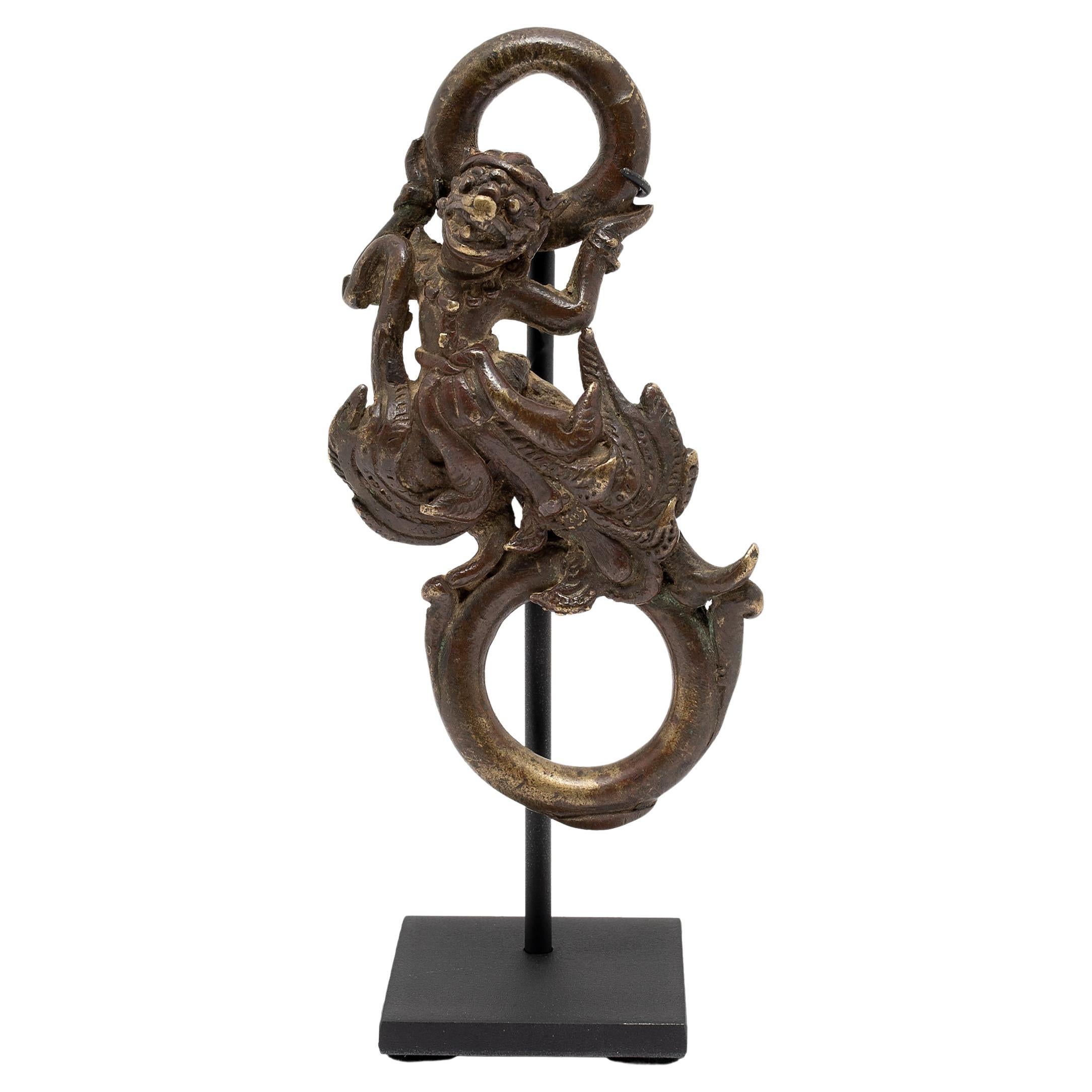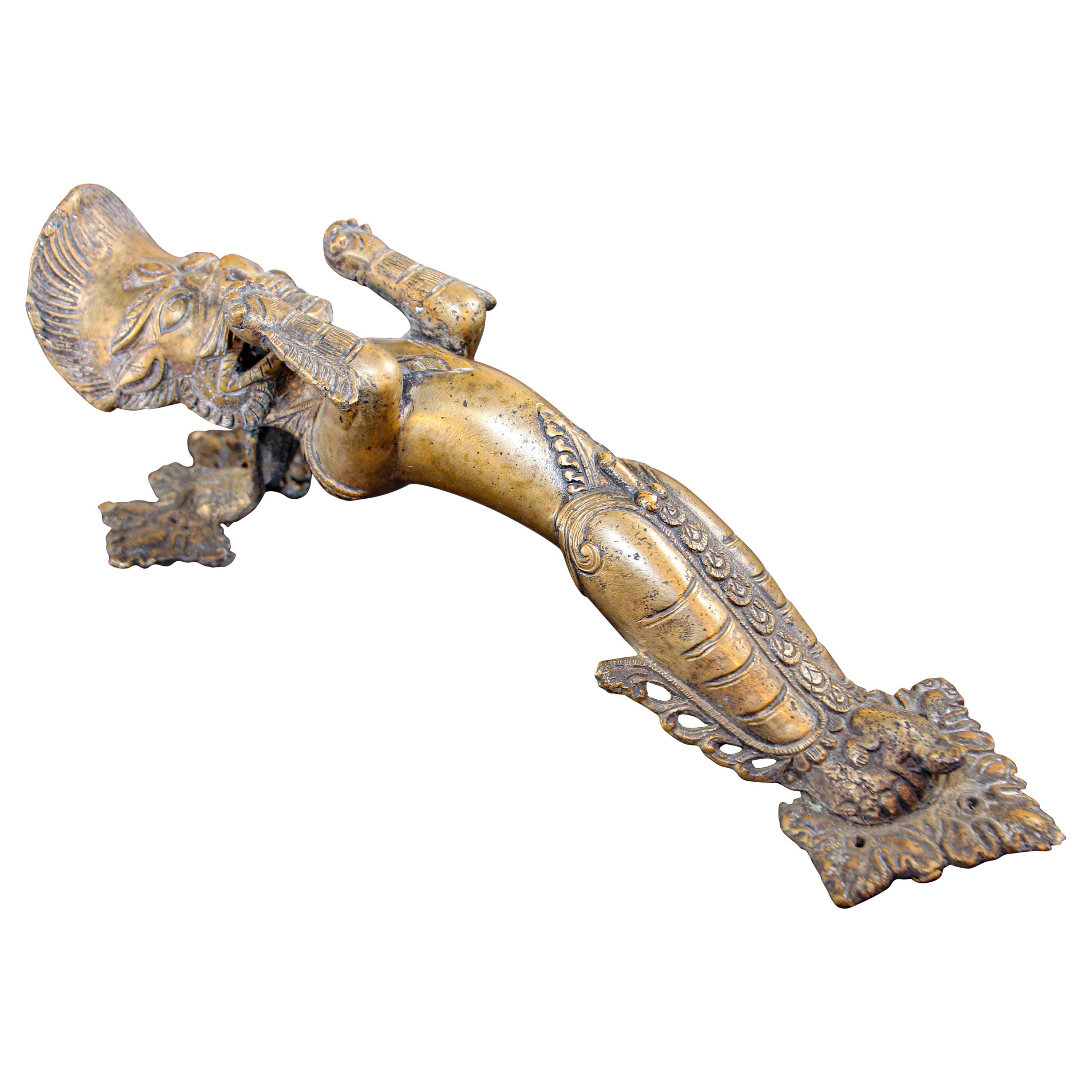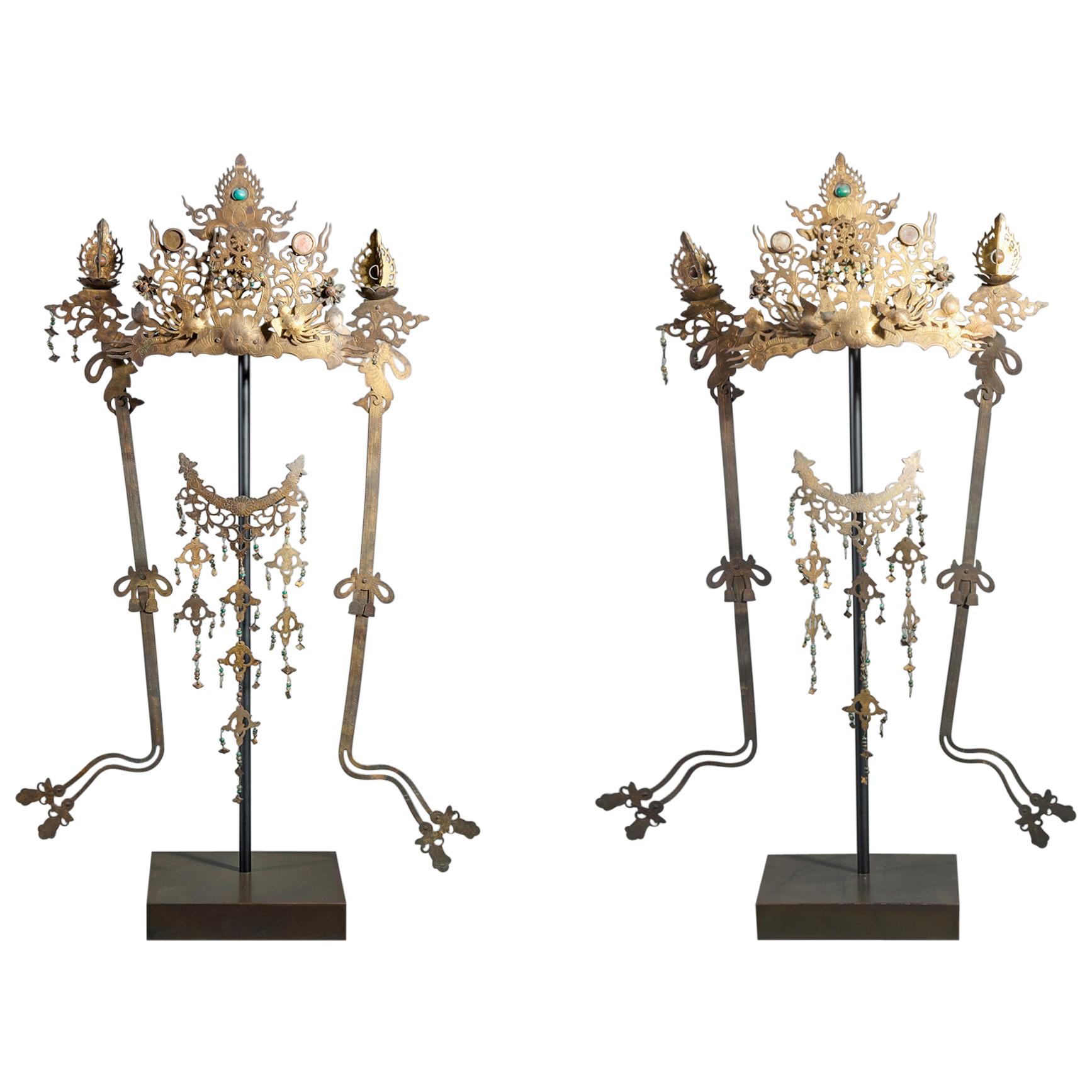Items Similar to Phurba or Kila Wrathful Sacred Buddhist Sword
Video Loading
Want more images or videos?
Request additional images or videos from the seller
1 of 20
Phurba or Kila Wrathful Sacred Buddhist Sword
About the Item
Large Phurba ornate with semi precious stones, like turquoise and red stones incrusted in brass metal.
The Phurba or Kila: the most potent of wrathful ritual implements in Vajrayana Buddhism, symbolizes the Karma activity of the Buddhas.
Contrary to the fictional portrayals of the Phurba in Hollywood movies, the Phurba is far from being any sort of weapon — but it is very active
The Bell and Vajra are sacred and special — but ubiquitous; the Phurba is iconic of the mysteries of higher practices in Vajrayana Buddhism. One of its esoteric names is “Diamantine Dagger of Emptiness.”
“The triple-bladed ritual dagger essentially symbolizes the powerful Buddha-activity of the wrathful deity…”, writes Robert Beer in his Handbook of Tibetan Buddhist Symbols. Like Tara — only more wrathfully — the Phurba represents the activity of the Buddhas.
“The tantric use of the phurba encompasses the curing of disease, exorcism, killing demons, meditation, consecrations (puja), and weather-making,” according to Tantra in the Himilayas. “The blade of the phurba is used for the destruction of demonic powers. The top end of the phurba is used by the tantrikas for blessings.”
In fact, one definition of the Phurba (Kila or Kilaka in Sanskrit) is “activity of the Buddhas.” In other words, from a purely “symbolic function” point of view, the Phurba represents the activity and wrath of all the Buddhas.
It is a primary symbol, just as the “Red Lotus” represents the “Speech” of all the Buddhas or the Jewel representing “Body”. These typically align with the ritual implements or symbol of the five Buddha Families (Vajrakilaya being of the Karma group) — although all of these symbols have many profound meanings beyond this simple list:
Vajra, representing “Mind”
Lotus (especially Red Lotus) representing “Speech”
Jewel or Ratna representing “Body”
Phurba (wrathful sword) or sword or double Vajra (whirling Vajra) representing the Karma family or “Activity” (Karma, good or bad, is created by activity)
Bell or 8-Spoked wheel: Emptiness or Space (opposite of the skhanda “form”. The bell represents Emptiness at a profound feminine level, the 8-Spoked Wheel typically refers more to the Buddha Dharma, the “icon” of the Buddha Family.
Symbolically, none of these stand alone, since, for example, the Phurba typically (but not always) contains a full vajra in the handle, and two lotus thrones; the Vajra also contains Lotus thrones and jewels, the Bell contains a Vajra, lotus thrones, jewels (pearls), Wisdom deity, and so on.
The reality is far from the movie-and fan-dom ideals. The symbolism of a Phurba is very profound — more complex and intricate than most other ritual implements. In some accounts, its beginnings are quite humble: the three sided tent peg (or Yurt peg). In more reliable histories, Phurba and its practice came from India from the Mahasiddhas. It has also found in Shamanic practice. Regardless of its beginnings, its practice is preserved in lineages going back many hundreds of years. In Tibet, the Phurba is very sacred and its practice is considered a “higher yoga.”
Triple-edged blade symbolizes the severance of the three root poisons of ignorance, greed and aggression. Its flaming triangular shape and vajra nature represent the realization of emptiness as the vajra-wrath that burns and cuts through hatred. The blade issues from the open mouth of a makara [half terrestrial, half aquatic animal in the form of a ‘ferocious striker’. Here the head of the makara symbolizes the ferocious power and tenacity of the phurba as an indestructible weapon. Pairs of coiling naga-serpents descend from the mouth of the makara in each of the recesses of the three blades. These nagas collectively represent the six perfections, the symbolism which is also embodied in Vajrakilaya’s six arms.”
The Deity Handle
The deity handle, mirroring the three-edges of the blade, has three deity faces. Typically, one might be wrathful, one peaceful and one joyful, (representing respectively Body, Speech and Mind).
Alternately, the three faces can be three deities, “The white right face is usually identified as the deity Yamantaka (or Trailokyavijaya), who represents the the aspect of body and the destruction of hatred. The blue central face is Amtrita Kundalin, who represents the aspect of mind and the destruction of delusion. The red left face is that of Hayagriva, who represents the aspect of speech, and the destruction of greed.”
Phurba is used by practitioners in both meditation and ritual. It is not an implement for the uninitiated. Normally, it would be “consecrated” for use. In some traditions, you’d see a string wound around the handle. If the Phurba is consecrated, normally the faces and handle are covered with blue cloth when used in front of the uninitiated (in some traditions). In shamanic practices, this may be different.
Only those initiated or empowered can or should use a Phurba. It is basically just a nice sculpture in the hands of the uninitiated. Although the Phurba appears to be physical, it’s primary presence, power and activity is on the mind and the spirit.
The biggest ritual uses tend to be:
purify and consecrate land (for building, temples, or just daily meditation/ritual)
daily meditations and visualizations of the deity
bless (deity end)
to heal (deity end)
to removed/banish negative energies (blade end)
to consecrate and empower (deity end)
to purify land (for construction, or prior to erecting a tent or building or yurt) (blade normally goes right into the ground) — in effect, the Phurba blade symbolically connects Space (Akasa in Sanskrit) to the Earth, establishing a continuum
to make offerings (with mudras)
exorcisms: although an exorcism in Buddhism is different from the Western approach: rather than banishment or destruction, the exorcist has to consider all sentient beings — including destructive ghosts or demons. Even if they are expelled from, for example a human host (or, from a non-supernatural point of view, a negative affliction symbolically banished from a person who is suffering) the spirit is typically either encouraged to rebirth (for ghosts) or bound to not harm creatures and to serve the Dharma (demons). (Again, symbolically, “binding a demon to the Dharma can be viewed as converting our negative “anger” into positive Dharma activity.)
binding spirits to the Dharma (oath binding), as exemplified in the activities of Padmasambhava when he came to Tibet.
To practice with the Phurba requires either initiation or empowerment or at least Highest Yoga Tantra initiation.
Decorated with turquoise stones and red precious stones, brass and metal it is a very decorative powerful Buddhist element.
- Dimensions:Height: 20 in (50.8 cm)Width: 4.5 in (11.43 cm)Depth: 4.5 in (11.43 cm)
- Style:Folk Art (In the Style Of)
- Materials and Techniques:
- Place of Origin:
- Period:
- Date of Manufacture:1950
- Condition:Wear consistent with age and use.
- Seller Location:North Hollywood, CA
- Reference Number:
About the Seller
5.0
Platinum Seller
These expertly vetted sellers are 1stDibs' most experienced sellers and are rated highest by our customers.
1stDibs seller since 2011
2,639 sales on 1stDibs
Typical response time: 1 hour
- ShippingRetrieving quote...Ships From: North Hollywood, CA
- Return PolicyA return for this item may be initiated within 7 days of delivery.
More From This SellerView All
- Vintage Buddhist Bronze Protector Deity Statue Door HandleLocated in North Hollywood, CAVintage Buddhist protector deity statue bronze heavy, ornate, symbolic, fertility symbol door handle from old temple Heavy bronze door handle in the ...Category
Early 20th Century Nepalese Tibetan Metalwork
MaterialsBronze
- Handcrafted Tinned Copper Metal Betel or Spices Caddy BoxLocated in North Hollywood, CABeautiful handcrafted tinned copper decorative octagonal betel box with lid and brass latch. The metal is delicately and intricately hand-hammered and repousse with floral and geometric designs. This Vintage brass box...Category
Early 20th Century Indian Anglo-Indian Decorative Boxes
MaterialsBrass
- Antique Islamic Dallah Arabic Turkish Brass Coffee Pot or Tea PotLocated in North Hollywood, CAAntique Islamic Dallah Arabic Turkish Brass Coffee Pot or Tea Pot. Middle Eastern Dallah Arabic brass coffee pot with birds and geometric etched triba...Category
Early 20th Century Turkish Islamic Metalwork
MaterialsBrass
- Antique Brass Baby Rattle Whistle Bell Dangles, IndiaLocated in North Hollywood, CAAntique brass baby rattle whistle bell dangles, India. Handcrafted baby rattle in openwork designs with whistle handle and three decorative bell dangles. ...Category
Mid-20th Century Indian Folk Art Metalwork
MaterialsBrass
- Hand-Hammered Raj Black Metal JugBy RajhastaniLocated in North Hollywood, CARaj large hand-hammered and hand-painted metal vessel, originally used to collect waters of the three sacred rivers, the Ganges and Yamuna Sarasvati. This large jug is much more than...Category
Mid-20th Century Indian Folk Art Metalwork
MaterialsMetal
- Antique Hindu Make Up Brass Box with PeacocksLocated in North Hollywood, CAAntique Hindu make up vermilion and eye liner brass box holder. This is an antique Mughal style brass Indian ornate locking Tikka box container. It has ...Category
Antique Late 19th Century Indian Folk Art Metalwork
MaterialsBrass
You May Also Like
- Bronze Wrathful Deity Ring, c. 1900Located in Chicago, ILThis sculptural bronze object is a charming example of 19th-century metalwork. The bronze figure is formed as a Buddhist wrathful deity, weari...Category
Early 20th Century Chinese Qing Mounted Objects
MaterialsBronze
- Large Himalayan Inlaid Bronze Vajra with Wrathful Faces, 15th-16th CenturyLocated in Austin, TXA large and unusual Himalayan bronze and mixed metal nine prong vajra featuring wrathful faces. In the style of the Tangut (Western Xia) Kingdom (1038 to 1227), but probably later, most likely 15th-16th century. The body of the vajra crafted from a copper alloy, with five wrathful faces on either side and gold and silver inlays to the center. The prongs crafted of iron, with each side having eight prongs arcing outwards around a central prong before coming back to a copper alloy point. The vajra is meditational tool...Category
Antique 16th Century Mongolian Metalwork
MaterialsGold, Silver, Bronze, Iron
- Antique Mongolian Buddhist Vase in copper with Brass decorationLocated in London, GBA fine Antique Mongolian Buddhist Vase in copper with Brass decoration with moving circular top piece Period 19th century Condition : Minor damages to baseCategory
Antique Late 19th Century Mongolian Tribal Art
MaterialsSilver, Brass, Copper
- Pair of Antique Japanese Buddhist Temple Headdress and Necklace OrnamentsLocated in Hudson, NYPair of antique Japanese Buddhist temple headdress and necklace ornaments. Gilt bronze with decorative stones and beads, and intricate metalw...Category
Antique Early 19th Century Japanese Edo Metalwork
MaterialsBronze
- Meiji Japanese Bronze Vase in Form of Buddhist Treasure SackLocated in New York, NYVery large and impressive Meiji period Japanese bronze vase in the form of the treasure sack of Hotei, Buddhist God of Happiness.Category
Antique Late 19th Century Japanese Meiji Metalwork
MaterialsBronze
- Indian Silvered Bronze Buddhist Deity Vajradhara Seated in Lotus PositionLocated in Stamford, CTWonderful small silvered bronze of Vajradhara. Indian, circa 1900. 7 inches high by 4 wide by 3 deep The Tibetan Buddhist deity Vajradhara is seated in a yogic meditation on a lotu...Category
Early 20th Century Indian Metalwork
MaterialsBronze





